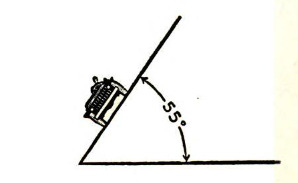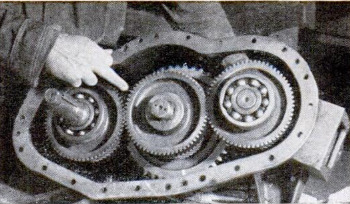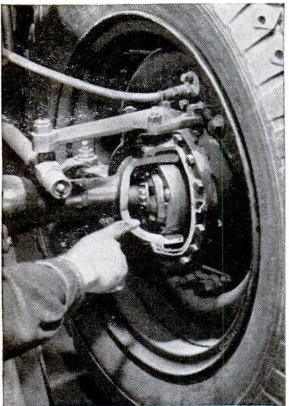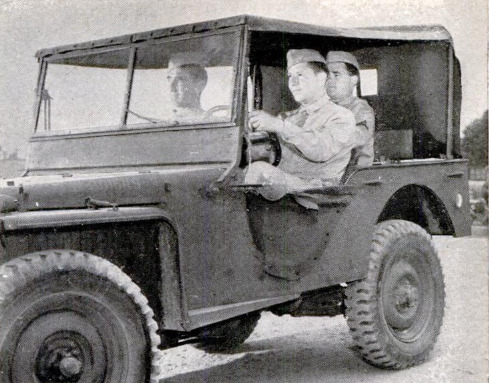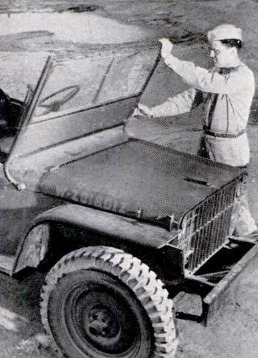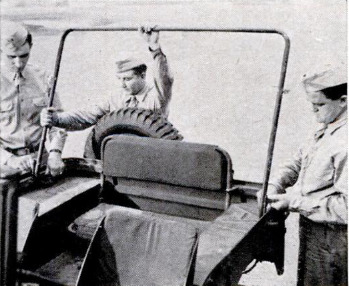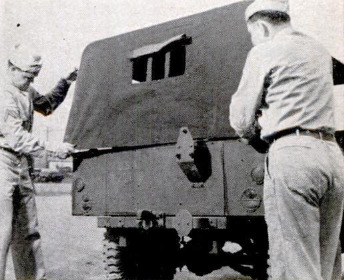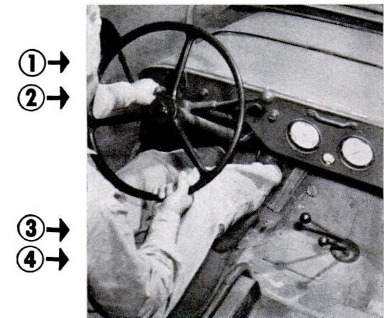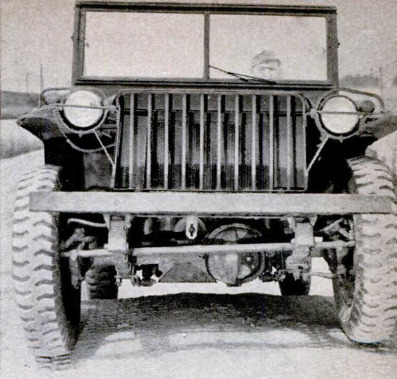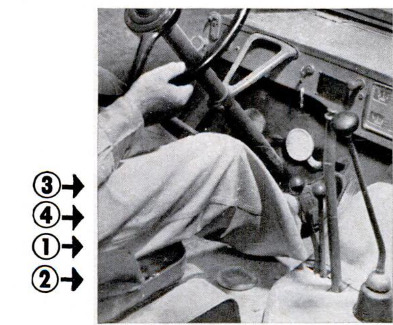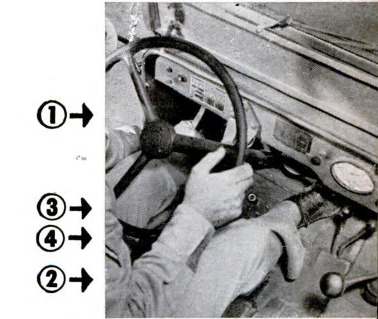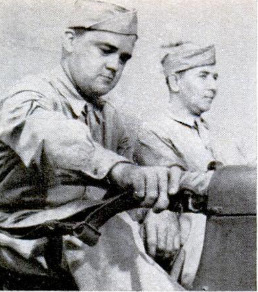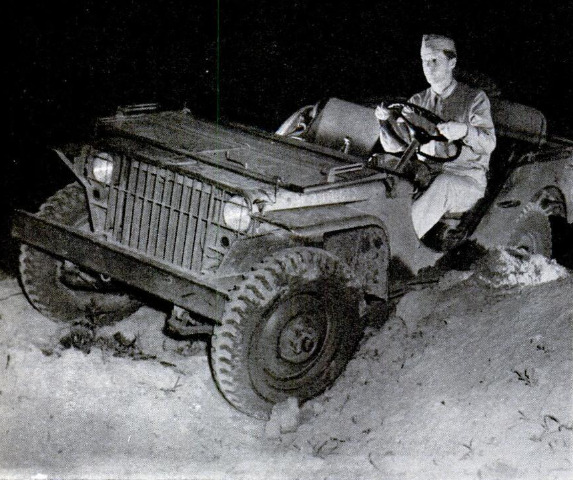-
Title (Dublin Core)
-
Leaping lena joins the army
-
Article Title and/or Image Caption (Dublin Core)
-
Title: Leaping lena joins the army
-
extracted text (Extract Text)
-
THERE'S a new piece of Army rolling
stock that has most of the soldiers,
from privates to generals, in a fever of
enthusiasm. It's officially known as a
quarter-ton reconnaissance truck, and the
enthusiasm arises from the fact that even
though it is the smallest, four-wheeled, self-
propelled vehicle the Quartermaster Corps
has purchased for the Army in large num-
bers, it can do more things than Army offi-
cials or manufacturers expected it to do.
When the first of these small cars was
delivered to the Army about a year ago, no-
body was quite sure just what it could do,
or what it could be used for. But after a
year of experimenting it is proving itself the
most versatile buggy since the development
of the chariot and new uses are still being
found for it in our complex war machine.
The artillery, the cavalry, the infantry,
every branch of the service is adapting them
to its particular needs. Already they are
being used for reconnaissance work, as mes-
senger vehicles, as prime movers for anti-
tank guns, as personnel carriers, as light
supply vehicles for front-line units. Their
speed and maneuverability enable them to
scoot for cover like jackrabbits when the
need arises, and they can travel across-
country like mountain goats. One cavalry
unit has found that by using the gasoline
tins used to supply vehicles in the field, they
can make a raft which will carry a quarter-
ton truck and which the truck can propel
itself by means of a portable paddle wheel
hooked up to one of the truck's rear wheels.
Stories and pictures of these amazing
wagons have been showing up everywhere,
but few of them tell just what goes into these
mighty midgets, what makes them tick and gives
them the “oomph” that is making so many converts
among the Army men, notoriously a pretty skepti-
cal crowd.
In spite of their spectacular performance, these
cars are in many ways similar to your family jal-
lopy. Steering wheels, brake and clutch pedals,
instruments, starter and throttle controls, are all
of standard make, similar to those found on com-
mercial cars. Tires are 5.50 by 16, or 6.00 by 16,
standard commercial sizes, though made with a
special tread. Any competent pleasure or com-
mercial-car driver can step into one and drive it
without any trouble.
They have been manufactured principally
by three companies—Ford, Bantam, and
‘Willys-Overland. Basically all of the bugs
are alike, though the products of the various
companies differ in minor details, such as
type of shift lever, horsepower of engine,
location of headlights, and location and
type of emergency-brake controls.
The one thing that all bugs have in com-
mon, and the thing that makes them able
to do such amazing things, is a selective
four-wheel drive, hooked up to a power
train that gives them six forward speeds
and two reverse.
Power plants are conventional L-head,
four-cylinder engines, ranging from more
than 60 horsepower in the Willys (basically
the same engine that is used in Willys cars)
down to about 45 in the Bantam, which is
powered with a Continental engine. The
Fords have a tractor engine.
All the engines have full force-feed lubri-
cation systems. They have to have that be-
cause they may be required to keep running
when the car is climbing a 65-percent grade
(about twice as steep as any highway grade
you will ever encounter) or running on a
side hill, where any other lubrication system
might result in burned-out bearings. Inci-
dentally, these cars can be tipped on their
sides to a 55-degree angle before they
will capsize.
Oil filler pipes, distributors, gener-
ators, batteries, and other electrical
units are placed as near the top of the
engine as possible so that the bugs
can ford streams with water over the
floor boards without stopping the en-
gines. All the bugs are equipped with
oversize oil filters and air cleaners
to strain out the dust—an important
consideration in view of the clouds of
sand and dust in which they are likely
to have to operate.
Power from the engines goes
through a standard-type transmission,
with a regular H-pattern shift (re-
verse and low on the left, second and
high on the right). Fords and Bantams
have shift levers in the floor, while
Willys put theirs on the steering post.
From the transmission the power goes
through a transfer case, a gear box which
has drive shafts leading fore and aft to
provide for the four-wheel drive. It also
has two sets of gears, controlled by means
of a lever in the floor beside the driver's
seat. These are what give the vehicle its
eight speeds. In the low range, used for
heavy pulling, with speeds running from a
few miles an hour in low, even with the
engine wide out, up to 25 or better in high,
the entire four positions in the transmission
can be selected.
Moving the lever forward shifts the trans-
fer case into its high range, in which the
transmission can again be used in all four
steps, with speeds in each case about double
what they are in low range. A bug, in high
range, can really travel. Though the rated
top speed, which the Army boys are sup-
posed to observe to lengthen the life of the
vehicle, is only 55 miles an hour in upper
high, they have on more than one occasion
done much more than this, and they are
officially good for 15 m.ph. in reverse.
They can better 30 mph. in high range
intermediate.
In the floor of the car, beside the transfer
case control, is a lever which controls the
front-wheel drive. This can be locked in for
heavy going, or cut out for high-speed work
on the highways. Because the low gear
range transmits so much power that it
might twist the rear driving axles and shaft
like wet noodles if all the power went into
a two-wheel drive, there is a lock which pre-
vents the driver from shifting the transfer
case into low range until the front-wheel
drive is locked in. That spreads the power to
all four wheels.
That front-wheel drive embodies one of
the important units used in practically all
Army vehicles, a unit on which Quarter-
master Corps and commercial engineers
worked for years before it reached its present
stage of perfection. It is the combined driv-
ing and steering joint with which the front
wheels are mounted on the axle housing.
Before it was developed, the universal
Joints used in front wheels imparted a jerky
motion to the wheels when they were
cramped one way or the other, causing ex-
cessive wear and loss of power. The new
unit, which uses a series of balls operating
in curved races to transmit the power to the
wheels, permits the wheels to be cramped
30 degrees to either side, and used in any
position in between without appreciable
Jerks or loss of power.
One thing the Army learned about its
quarter-tons when it began to use them in
rough cross-country work was that hy-
draulic-brake tubes, leading from the master
cylinder to the wheels, were plenty vulner-
able to underbrush and other obstructions
unless they were protected. Now they have
worked out a system of leading the tubing
along the rear sides of the differentials,
fastened securely to them, so that it can't
be caught and ripped out.
Another thing learned through experience
in the field was that the trucks’ folding wind-
shields just weren't going to stay put unless
they were securely fastened. Now they
have hooks on the sides of the hood to fasten
them down when they are used in that posi-
tion, and more hooks to fasten them in place
when they are up.
The official name for the trucks. “quarter-
ton,” vehicles, is a bit misleading. Actually,
the first ones built were designed to carry
just about that weight—500 pounds. But
since then they have been improved so that
they can carry 800 pounds, and in addition
tow a 1,000-pound load, which is roughly the
weight of the 37-mm. antitank gun which
they pull.
If desirable, it is possible to bolt a
machine-gun mount to the floor of the body
between the two front seats. With a .80 or
.50 caliber gun mounted there, and a crew
of three men, they can be used for patroiling
or reconnaissance work. With their wheel-
base of only 84 inches, a good three feet less
than the average car, they can be manev-
vered almost anywhere. They make excel
lent units for liaison work, because they
travel fast, and don’t
need paved roads on
which to do it. Some of
the trucks, in experi-
ments to improve their
already excellent maneu-
verability, have been
built with a four-wheel
steering arrangement
and a four-wheel drive,
There's a story in the
Army to the effect that a
lot of capable officers
are quite chagrined these
days, because when the
Bantam company began
trying to sell the Army
on the idea of a flock of
miniature trucks, they
didn't like it. Finally,
however, the idea got to
the ears of somebody:
near the top, and he said it was worth a try
at least. So an order was placed for 70 of
them, a little over a year ago.
The first model turned out set something
of a record. Within 49 days from the time
the contract was signed for that order, the
first, or pilot model, was
delivered to the Holabird
Quartermaster Depot,
Baltimore, Md., for test-
ing. So it is easy to un-
derstand why, while all
the Army is enthusiastic
about its new all-purpose
car, the bug is the special
pride and joy of the
Quartermaster Corps,
which was directly re-
sponsible for the design
and testing of the new ve-
hicle. It's the Army's car-
of-all-work, but Quarter-
master Corps’ baby.
It's a safe bet that you
will be seeing more and
more of them doing serv-
ice for the Army in the
near future. And if the
time comes that the Army doesn't need all
the production of the automobile factories,
it's extremely likely that many of the things
learned by the manufacturers in construct-
ing taese versatile vehicles will help them to
make your family automobile a better car.
-
Contributor (Dublin Core)
-
David M. Stearns (article writer)
-
Language (Dublin Core)
-
Eng
-
Date Issued (Dublin Core)
-
1941-10
-
pages (Bibliographic Ontology)
-
52-58
-
Rights (Dublin Core)
-
Public domain
-
Archived by (Dublin Core)
-
Sami Akbiyik
 Popular Science Monthly, v. 139, n. 4, 1941
Popular Science Monthly, v. 139, n. 4, 1941
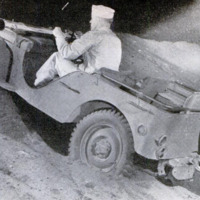 Screenshot_2.png
Screenshot_2.png Screenshot_3.png
Screenshot_3.png Screenshot_4.png
Screenshot_4.png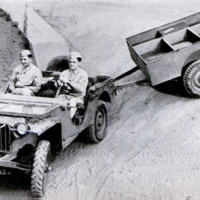 Screenshot_5.png
Screenshot_5.png Screenshot_6.png
Screenshot_6.png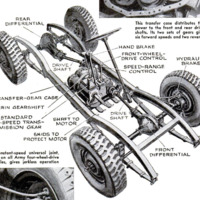 Screenshot_7.png
Screenshot_7.png Screenshot_8.png
Screenshot_8.png Screenshot_9.png
Screenshot_9.png Screenshot_10.png
Screenshot_10.png Screenshot_11.png
Screenshot_11.png Screenshot_12.png
Screenshot_12.png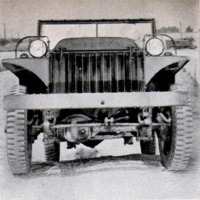 Screenshot_13.png
Screenshot_13.png Screenshot_14.png
Screenshot_14.png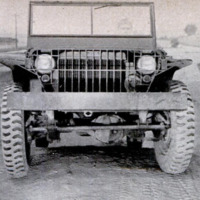 Screenshot_15.png
Screenshot_15.png Screenshot_16.png
Screenshot_16.png Screenshot_17.png
Screenshot_17.png Screenshot_18.png
Screenshot_18.png Screenshot_19.png
Screenshot_19.png Screenshot_20.png
Screenshot_20.png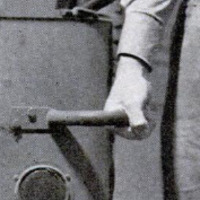 Screenshot_21.png
Screenshot_21.png


